Business and Business Environment: Report on Tesco and Sainsbury's
VerifiedAdded on 2023/01/10
|15
|4311
|97
Report
AI Summary
This report delves into the business environment, exploring various organizational types like public, private, and voluntary sectors, alongside their respective purposes and legal structures. It examines the size and scope of organizations, using examples such as Tesco, NHS, and Oxfam. The report further analyzes organizational structures, including functional, divisional, and matrix structures, and their impact on the relationship between different organizational functions such as marketing, production, sales, and human resources. A significant portion of the report is dedicated to a PESTLE analysis of Tesco Ltd., assessing the positive and negative impacts of political, economic, social, technological, legal, and environmental factors on its operations. Furthermore, the report includes a SWOT analysis of both Tesco and Sainsbury’s, evaluating their internal strengths and weaknesses in relation to external environmental influences. The conclusion summarizes the key findings and insights from the analysis.
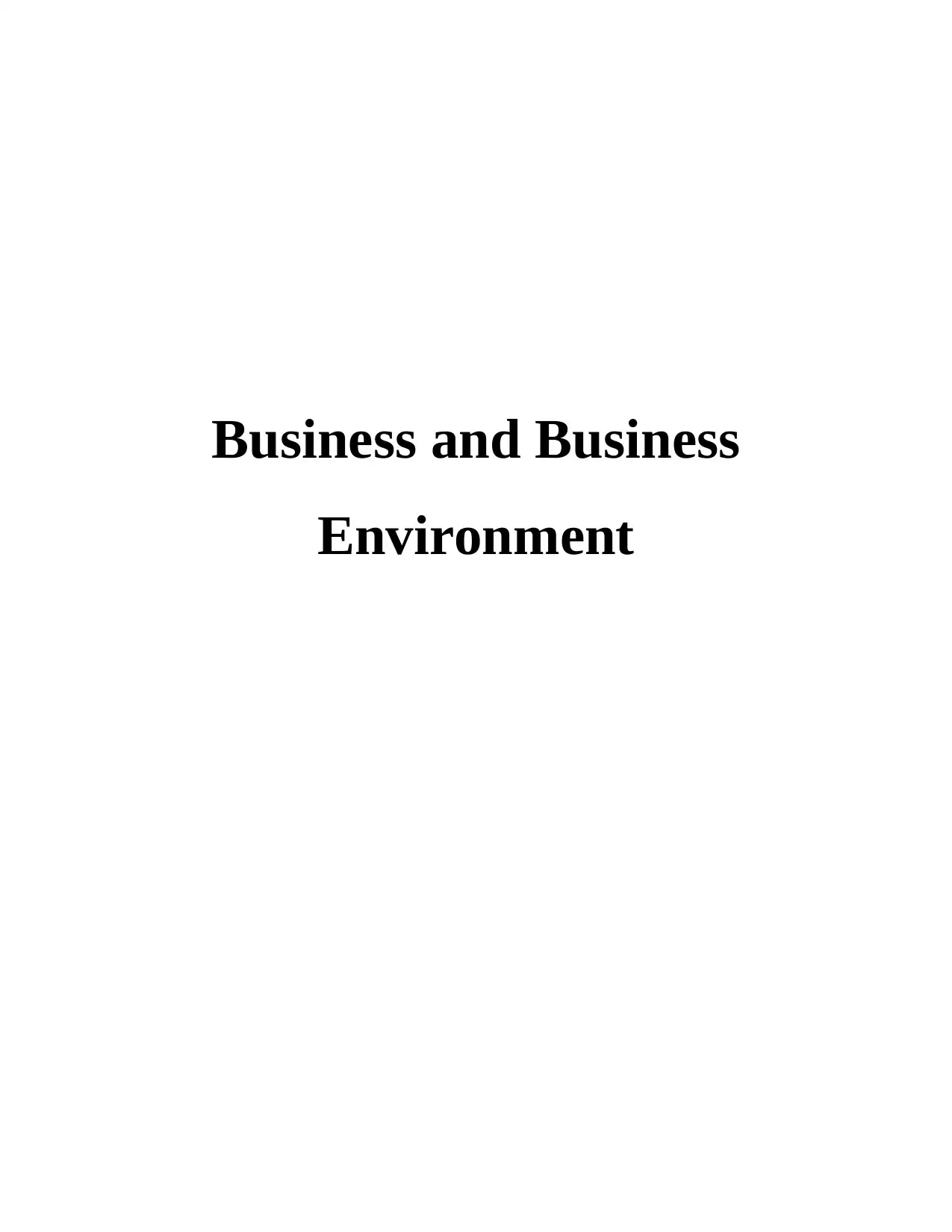
Business and Business
Environment
Environment
Paraphrase This Document
Need a fresh take? Get an instant paraphrase of this document with our AI Paraphraser
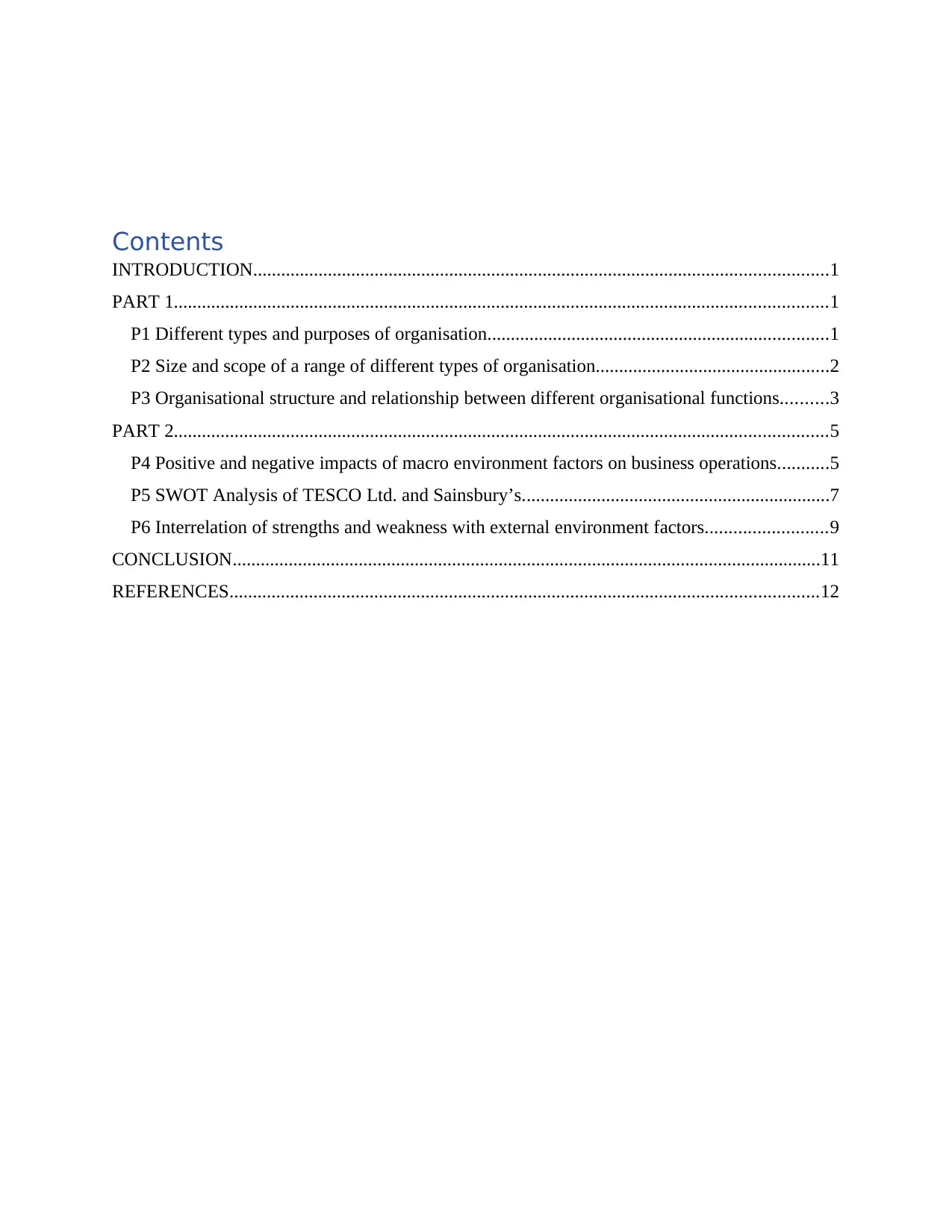
Contents
INTRODUCTION...........................................................................................................................1
PART 1............................................................................................................................................1
P1 Different types and purposes of organisation.........................................................................1
P2 Size and scope of a range of different types of organisation..................................................2
P3 Organisational structure and relationship between different organisational functions..........3
PART 2............................................................................................................................................5
P4 Positive and negative impacts of macro environment factors on business operations...........5
P5 SWOT Analysis of TESCO Ltd. and Sainsbury’s..................................................................7
P6 Interrelation of strengths and weakness with external environment factors..........................9
CONCLUSION..............................................................................................................................11
REFERENCES..............................................................................................................................12
INTRODUCTION...........................................................................................................................1
PART 1............................................................................................................................................1
P1 Different types and purposes of organisation.........................................................................1
P2 Size and scope of a range of different types of organisation..................................................2
P3 Organisational structure and relationship between different organisational functions..........3
PART 2............................................................................................................................................5
P4 Positive and negative impacts of macro environment factors on business operations...........5
P5 SWOT Analysis of TESCO Ltd. and Sainsbury’s..................................................................7
P6 Interrelation of strengths and weakness with external environment factors..........................9
CONCLUSION..............................................................................................................................11
REFERENCES..............................................................................................................................12

⊘ This is a preview!⊘
Do you want full access?
Subscribe today to unlock all pages.

Trusted by 1+ million students worldwide
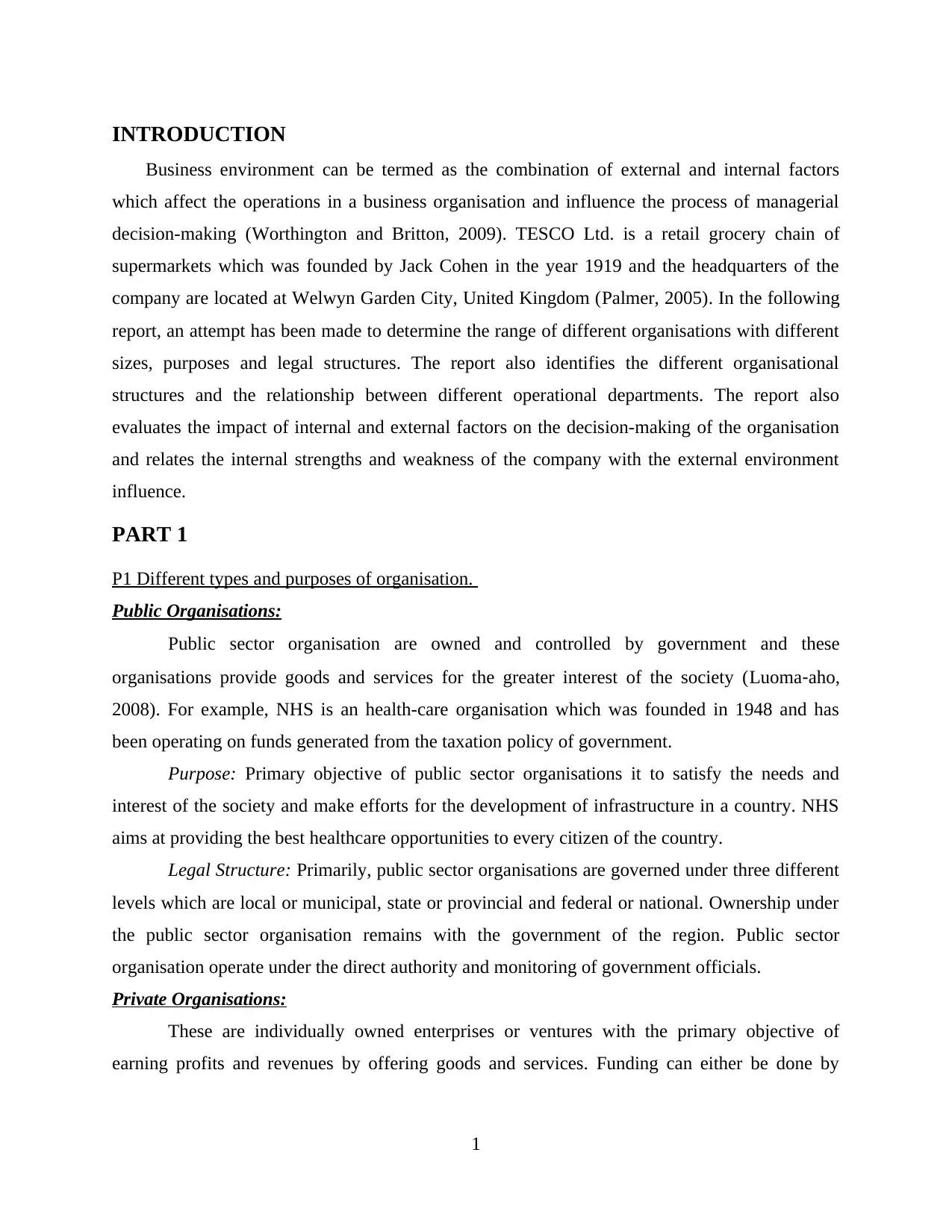
INTRODUCTION
Business environment can be termed as the combination of external and internal factors
which affect the operations in a business organisation and influence the process of managerial
decision-making (Worthington and Britton, 2009). TESCO Ltd. is a retail grocery chain of
supermarkets which was founded by Jack Cohen in the year 1919 and the headquarters of the
company are located at Welwyn Garden City, United Kingdom (Palmer, 2005). In the following
report, an attempt has been made to determine the range of different organisations with different
sizes, purposes and legal structures. The report also identifies the different organisational
structures and the relationship between different operational departments. The report also
evaluates the impact of internal and external factors on the decision-making of the organisation
and relates the internal strengths and weakness of the company with the external environment
influence.
PART 1
P1 Different types and purposes of organisation.
Public Organisations:
Public sector organisation are owned and controlled by government and these
organisations provide goods and services for the greater interest of the society (Luoma‐aho,
2008). For example, NHS is an health-care organisation which was founded in 1948 and has
been operating on funds generated from the taxation policy of government.
Purpose: Primary objective of public sector organisations it to satisfy the needs and
interest of the society and make efforts for the development of infrastructure in a country. NHS
aims at providing the best healthcare opportunities to every citizen of the country.
Legal Structure: Primarily, public sector organisations are governed under three different
levels which are local or municipal, state or provincial and federal or national. Ownership under
the public sector organisation remains with the government of the region. Public sector
organisation operate under the direct authority and monitoring of government officials.
Private Organisations:
These are individually owned enterprises or ventures with the primary objective of
earning profits and revenues by offering goods and services. Funding can either be done by
1
Business environment can be termed as the combination of external and internal factors
which affect the operations in a business organisation and influence the process of managerial
decision-making (Worthington and Britton, 2009). TESCO Ltd. is a retail grocery chain of
supermarkets which was founded by Jack Cohen in the year 1919 and the headquarters of the
company are located at Welwyn Garden City, United Kingdom (Palmer, 2005). In the following
report, an attempt has been made to determine the range of different organisations with different
sizes, purposes and legal structures. The report also identifies the different organisational
structures and the relationship between different operational departments. The report also
evaluates the impact of internal and external factors on the decision-making of the organisation
and relates the internal strengths and weakness of the company with the external environment
influence.
PART 1
P1 Different types and purposes of organisation.
Public Organisations:
Public sector organisation are owned and controlled by government and these
organisations provide goods and services for the greater interest of the society (Luoma‐aho,
2008). For example, NHS is an health-care organisation which was founded in 1948 and has
been operating on funds generated from the taxation policy of government.
Purpose: Primary objective of public sector organisations it to satisfy the needs and
interest of the society and make efforts for the development of infrastructure in a country. NHS
aims at providing the best healthcare opportunities to every citizen of the country.
Legal Structure: Primarily, public sector organisations are governed under three different
levels which are local or municipal, state or provincial and federal or national. Ownership under
the public sector organisation remains with the government of the region. Public sector
organisation operate under the direct authority and monitoring of government officials.
Private Organisations:
These are individually owned enterprises or ventures with the primary objective of
earning profits and revenues by offering goods and services. Funding can either be done by
1
Paraphrase This Document
Need a fresh take? Get an instant paraphrase of this document with our AI Paraphraser
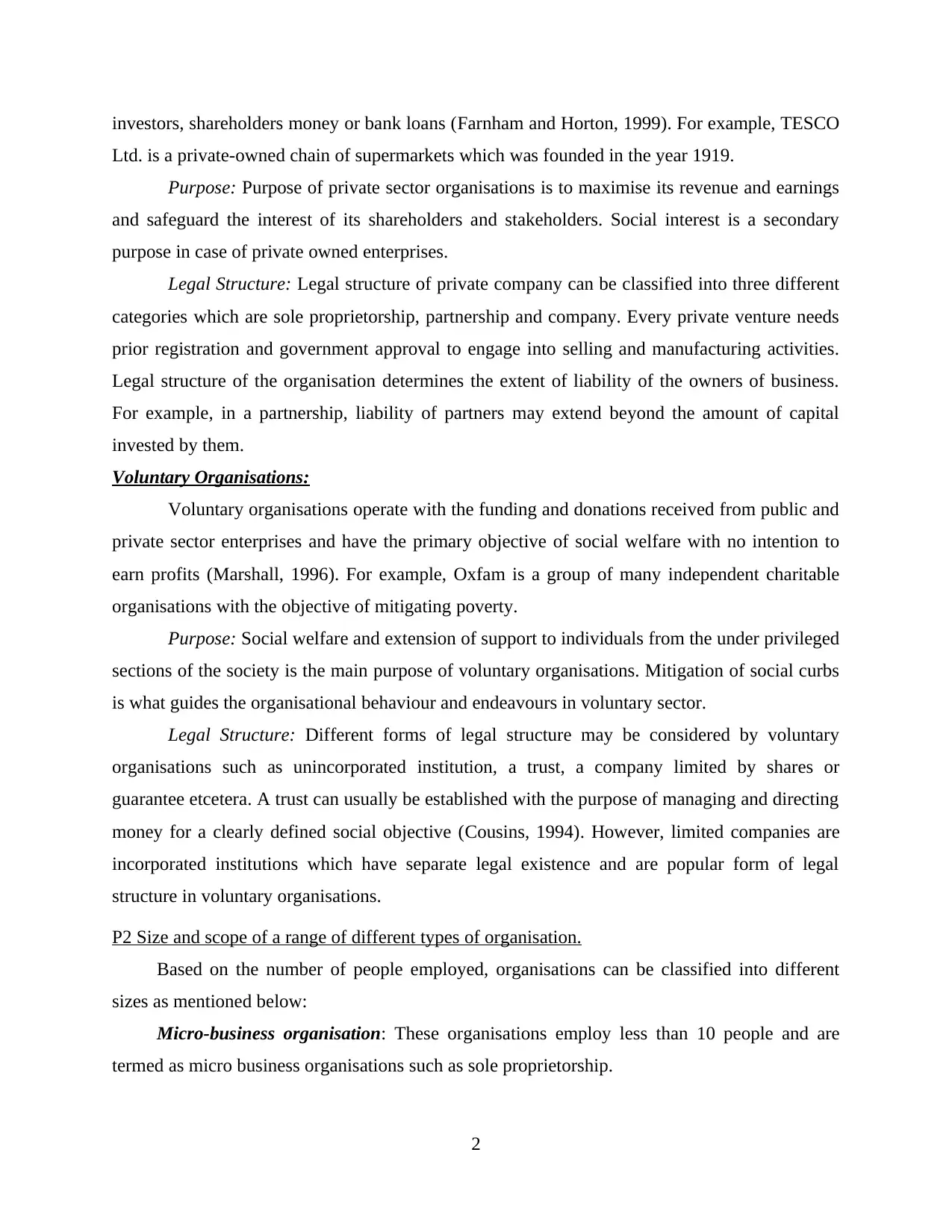
investors, shareholders money or bank loans (Farnham and Horton, 1999). For example, TESCO
Ltd. is a private-owned chain of supermarkets which was founded in the year 1919.
Purpose: Purpose of private sector organisations is to maximise its revenue and earnings
and safeguard the interest of its shareholders and stakeholders. Social interest is a secondary
purpose in case of private owned enterprises.
Legal Structure: Legal structure of private company can be classified into three different
categories which are sole proprietorship, partnership and company. Every private venture needs
prior registration and government approval to engage into selling and manufacturing activities.
Legal structure of the organisation determines the extent of liability of the owners of business.
For example, in a partnership, liability of partners may extend beyond the amount of capital
invested by them.
Voluntary Organisations:
Voluntary organisations operate with the funding and donations received from public and
private sector enterprises and have the primary objective of social welfare with no intention to
earn profits (Marshall, 1996). For example, Oxfam is a group of many independent charitable
organisations with the objective of mitigating poverty.
Purpose: Social welfare and extension of support to individuals from the under privileged
sections of the society is the main purpose of voluntary organisations. Mitigation of social curbs
is what guides the organisational behaviour and endeavours in voluntary sector.
Legal Structure: Different forms of legal structure may be considered by voluntary
organisations such as unincorporated institution, a trust, a company limited by shares or
guarantee etcetera. A trust can usually be established with the purpose of managing and directing
money for a clearly defined social objective (Cousins, 1994). However, limited companies are
incorporated institutions which have separate legal existence and are popular form of legal
structure in voluntary organisations.
P2 Size and scope of a range of different types of organisation.
Based on the number of people employed, organisations can be classified into different
sizes as mentioned below:
Micro-business organisation: These organisations employ less than 10 people and are
termed as micro business organisations such as sole proprietorship.
2
Ltd. is a private-owned chain of supermarkets which was founded in the year 1919.
Purpose: Purpose of private sector organisations is to maximise its revenue and earnings
and safeguard the interest of its shareholders and stakeholders. Social interest is a secondary
purpose in case of private owned enterprises.
Legal Structure: Legal structure of private company can be classified into three different
categories which are sole proprietorship, partnership and company. Every private venture needs
prior registration and government approval to engage into selling and manufacturing activities.
Legal structure of the organisation determines the extent of liability of the owners of business.
For example, in a partnership, liability of partners may extend beyond the amount of capital
invested by them.
Voluntary Organisations:
Voluntary organisations operate with the funding and donations received from public and
private sector enterprises and have the primary objective of social welfare with no intention to
earn profits (Marshall, 1996). For example, Oxfam is a group of many independent charitable
organisations with the objective of mitigating poverty.
Purpose: Social welfare and extension of support to individuals from the under privileged
sections of the society is the main purpose of voluntary organisations. Mitigation of social curbs
is what guides the organisational behaviour and endeavours in voluntary sector.
Legal Structure: Different forms of legal structure may be considered by voluntary
organisations such as unincorporated institution, a trust, a company limited by shares or
guarantee etcetera. A trust can usually be established with the purpose of managing and directing
money for a clearly defined social objective (Cousins, 1994). However, limited companies are
incorporated institutions which have separate legal existence and are popular form of legal
structure in voluntary organisations.
P2 Size and scope of a range of different types of organisation.
Based on the number of people employed, organisations can be classified into different
sizes as mentioned below:
Micro-business organisation: These organisations employ less than 10 people and are
termed as micro business organisations such as sole proprietorship.
2
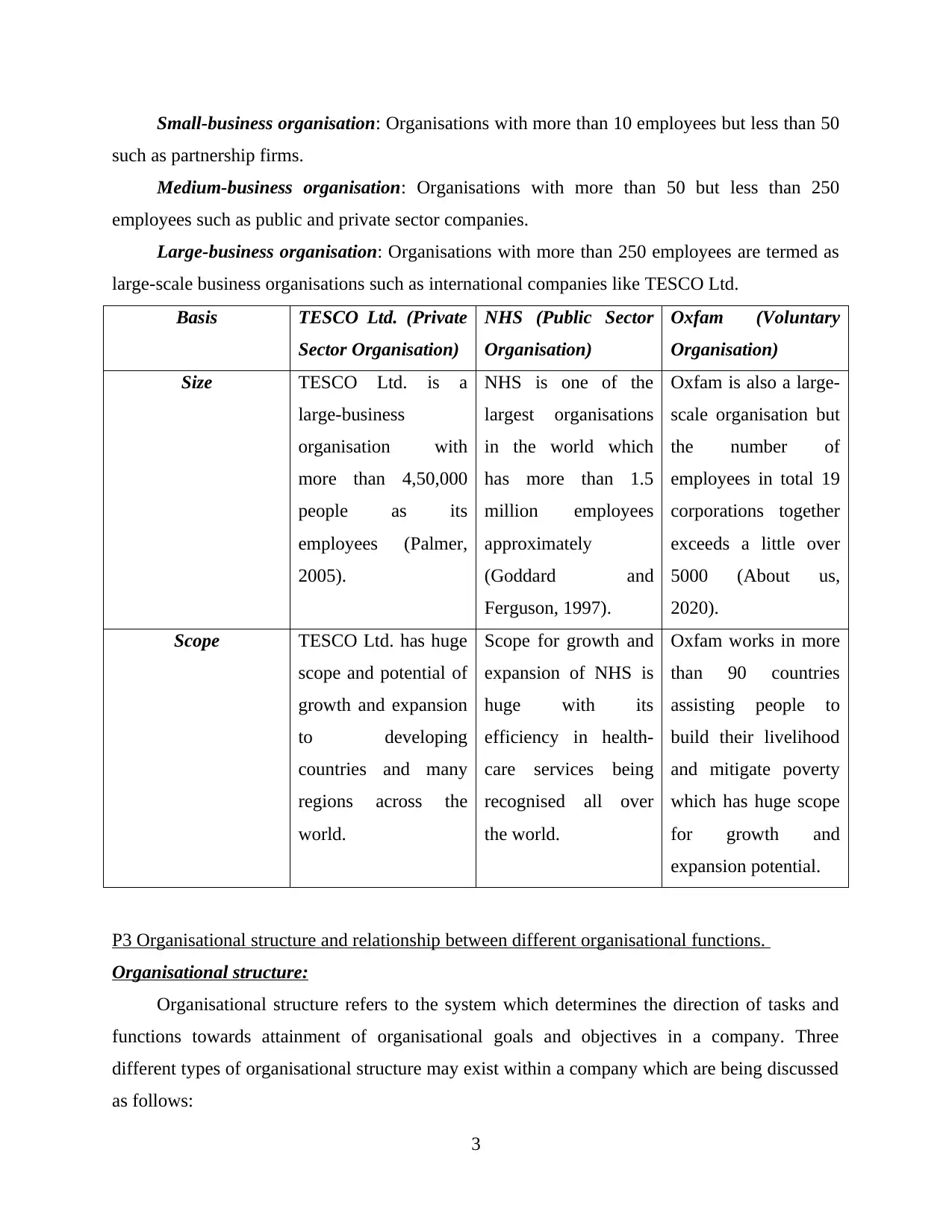
Small-business organisation: Organisations with more than 10 employees but less than 50
such as partnership firms.
Medium-business organisation: Organisations with more than 50 but less than 250
employees such as public and private sector companies.
Large-business organisation: Organisations with more than 250 employees are termed as
large-scale business organisations such as international companies like TESCO Ltd.
Basis TESCO Ltd. (Private
Sector Organisation)
NHS (Public Sector
Organisation)
Oxfam (Voluntary
Organisation)
Size TESCO Ltd. is a
large-business
organisation with
more than 4,50,000
people as its
employees (Palmer,
2005).
NHS is one of the
largest organisations
in the world which
has more than 1.5
million employees
approximately
(Goddard and
Ferguson, 1997).
Oxfam is also a large-
scale organisation but
the number of
employees in total 19
corporations together
exceeds a little over
5000 (About us,
2020).
Scope TESCO Ltd. has huge
scope and potential of
growth and expansion
to developing
countries and many
regions across the
world.
Scope for growth and
expansion of NHS is
huge with its
efficiency in health-
care services being
recognised all over
the world.
Oxfam works in more
than 90 countries
assisting people to
build their livelihood
and mitigate poverty
which has huge scope
for growth and
expansion potential.
P3 Organisational structure and relationship between different organisational functions.
Organisational structure:
Organisational structure refers to the system which determines the direction of tasks and
functions towards attainment of organisational goals and objectives in a company. Three
different types of organisational structure may exist within a company which are being discussed
as follows:
3
such as partnership firms.
Medium-business organisation: Organisations with more than 50 but less than 250
employees such as public and private sector companies.
Large-business organisation: Organisations with more than 250 employees are termed as
large-scale business organisations such as international companies like TESCO Ltd.
Basis TESCO Ltd. (Private
Sector Organisation)
NHS (Public Sector
Organisation)
Oxfam (Voluntary
Organisation)
Size TESCO Ltd. is a
large-business
organisation with
more than 4,50,000
people as its
employees (Palmer,
2005).
NHS is one of the
largest organisations
in the world which
has more than 1.5
million employees
approximately
(Goddard and
Ferguson, 1997).
Oxfam is also a large-
scale organisation but
the number of
employees in total 19
corporations together
exceeds a little over
5000 (About us,
2020).
Scope TESCO Ltd. has huge
scope and potential of
growth and expansion
to developing
countries and many
regions across the
world.
Scope for growth and
expansion of NHS is
huge with its
efficiency in health-
care services being
recognised all over
the world.
Oxfam works in more
than 90 countries
assisting people to
build their livelihood
and mitigate poverty
which has huge scope
for growth and
expansion potential.
P3 Organisational structure and relationship between different organisational functions.
Organisational structure:
Organisational structure refers to the system which determines the direction of tasks and
functions towards attainment of organisational goals and objectives in a company. Three
different types of organisational structure may exist within a company which are being discussed
as follows:
3
⊘ This is a preview!⊘
Do you want full access?
Subscribe today to unlock all pages.

Trusted by 1+ million students worldwide
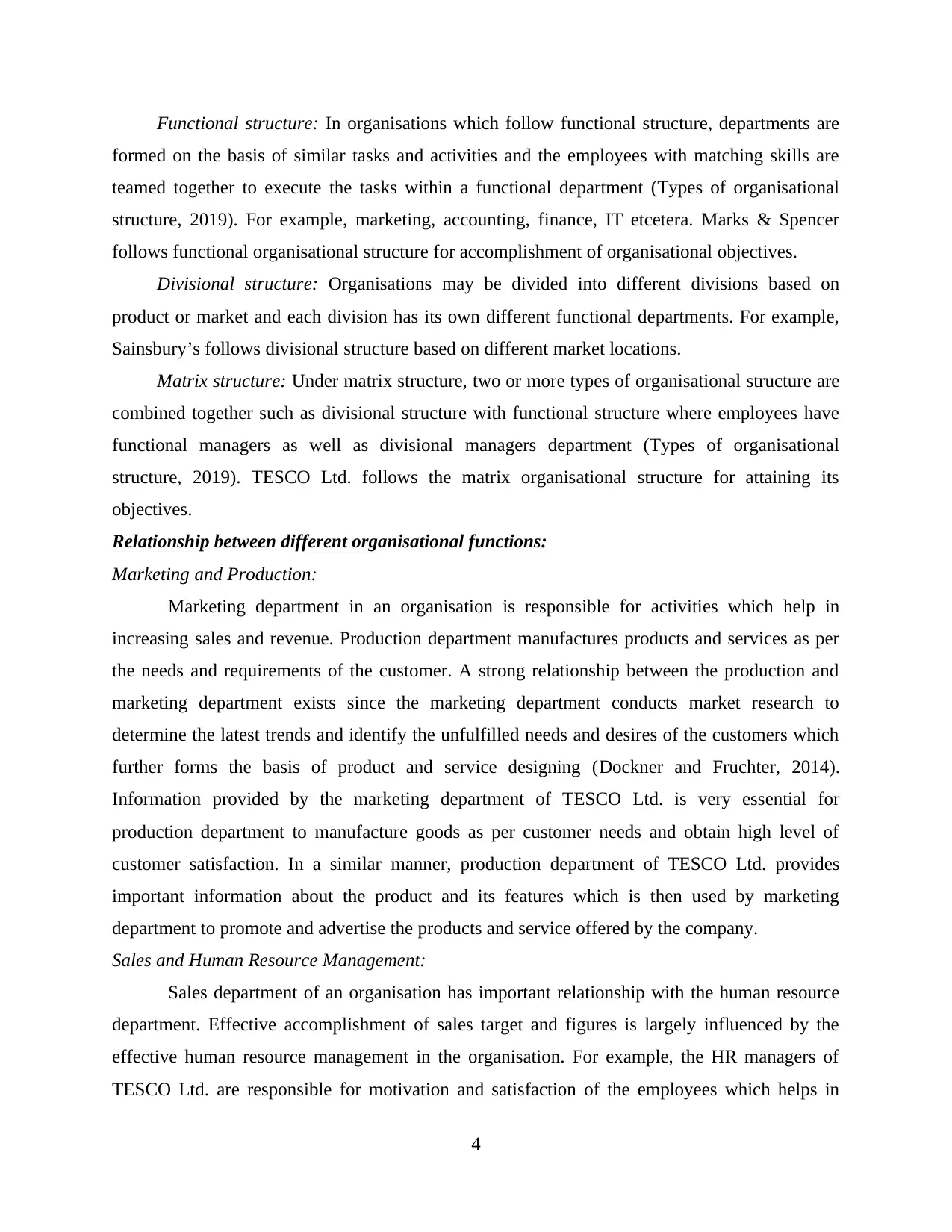
Functional structure: In organisations which follow functional structure, departments are
formed on the basis of similar tasks and activities and the employees with matching skills are
teamed together to execute the tasks within a functional department (Types of organisational
structure, 2019). For example, marketing, accounting, finance, IT etcetera. Marks & Spencer
follows functional organisational structure for accomplishment of organisational objectives.
Divisional structure: Organisations may be divided into different divisions based on
product or market and each division has its own different functional departments. For example,
Sainsbury’s follows divisional structure based on different market locations.
Matrix structure: Under matrix structure, two or more types of organisational structure are
combined together such as divisional structure with functional structure where employees have
functional managers as well as divisional managers department (Types of organisational
structure, 2019). TESCO Ltd. follows the matrix organisational structure for attaining its
objectives.
Relationship between different organisational functions:
Marketing and Production:
Marketing department in an organisation is responsible for activities which help in
increasing sales and revenue. Production department manufactures products and services as per
the needs and requirements of the customer. A strong relationship between the production and
marketing department exists since the marketing department conducts market research to
determine the latest trends and identify the unfulfilled needs and desires of the customers which
further forms the basis of product and service designing (Dockner and Fruchter, 2014).
Information provided by the marketing department of TESCO Ltd. is very essential for
production department to manufacture goods as per customer needs and obtain high level of
customer satisfaction. In a similar manner, production department of TESCO Ltd. provides
important information about the product and its features which is then used by marketing
department to promote and advertise the products and service offered by the company.
Sales and Human Resource Management:
Sales department of an organisation has important relationship with the human resource
department. Effective accomplishment of sales target and figures is largely influenced by the
effective human resource management in the organisation. For example, the HR managers of
TESCO Ltd. are responsible for motivation and satisfaction of the employees which helps in
4
formed on the basis of similar tasks and activities and the employees with matching skills are
teamed together to execute the tasks within a functional department (Types of organisational
structure, 2019). For example, marketing, accounting, finance, IT etcetera. Marks & Spencer
follows functional organisational structure for accomplishment of organisational objectives.
Divisional structure: Organisations may be divided into different divisions based on
product or market and each division has its own different functional departments. For example,
Sainsbury’s follows divisional structure based on different market locations.
Matrix structure: Under matrix structure, two or more types of organisational structure are
combined together such as divisional structure with functional structure where employees have
functional managers as well as divisional managers department (Types of organisational
structure, 2019). TESCO Ltd. follows the matrix organisational structure for attaining its
objectives.
Relationship between different organisational functions:
Marketing and Production:
Marketing department in an organisation is responsible for activities which help in
increasing sales and revenue. Production department manufactures products and services as per
the needs and requirements of the customer. A strong relationship between the production and
marketing department exists since the marketing department conducts market research to
determine the latest trends and identify the unfulfilled needs and desires of the customers which
further forms the basis of product and service designing (Dockner and Fruchter, 2014).
Information provided by the marketing department of TESCO Ltd. is very essential for
production department to manufacture goods as per customer needs and obtain high level of
customer satisfaction. In a similar manner, production department of TESCO Ltd. provides
important information about the product and its features which is then used by marketing
department to promote and advertise the products and service offered by the company.
Sales and Human Resource Management:
Sales department of an organisation has important relationship with the human resource
department. Effective accomplishment of sales target and figures is largely influenced by the
effective human resource management in the organisation. For example, the HR managers of
TESCO Ltd. are responsible for motivation and satisfaction of the employees which helps in
4
Paraphrase This Document
Need a fresh take? Get an instant paraphrase of this document with our AI Paraphraser
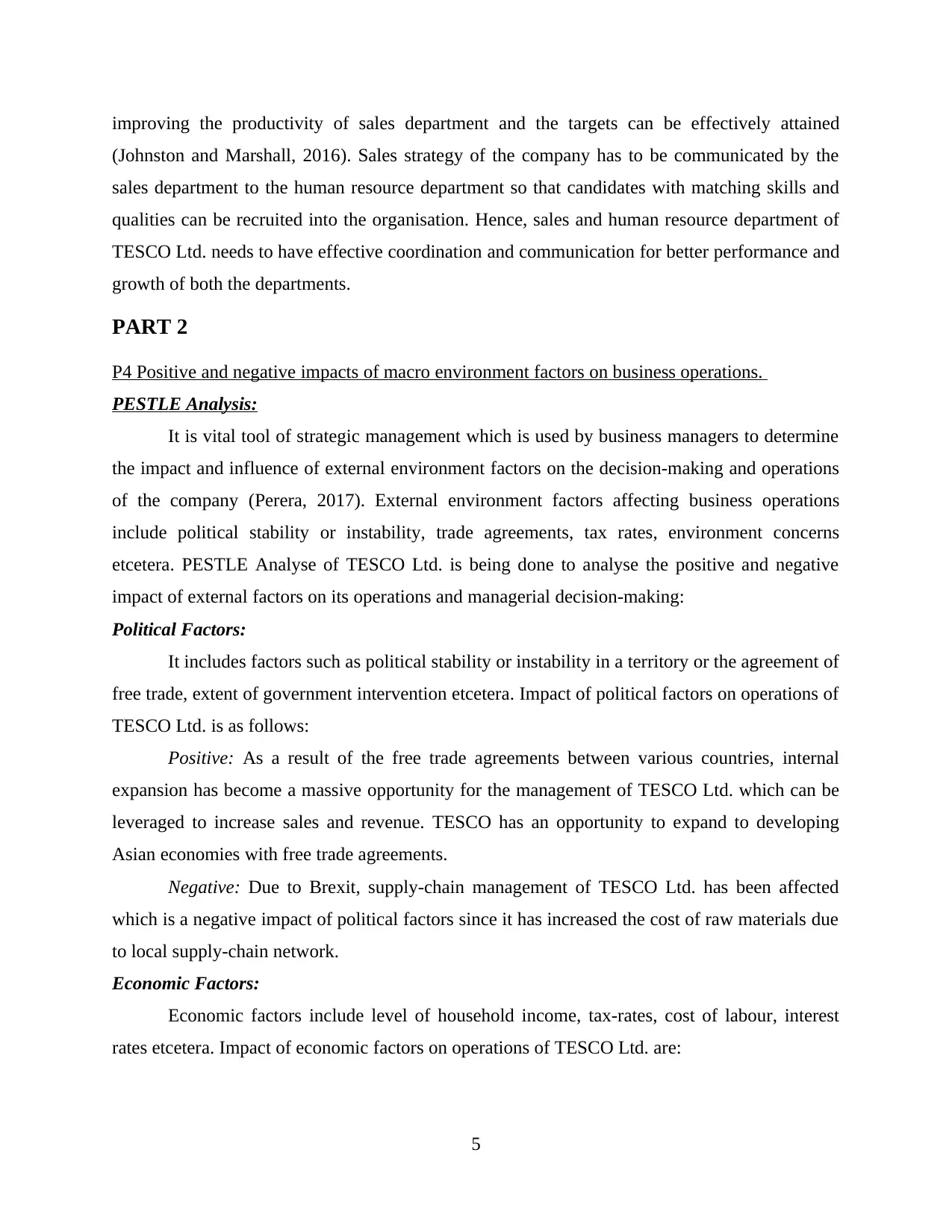
improving the productivity of sales department and the targets can be effectively attained
(Johnston and Marshall, 2016). Sales strategy of the company has to be communicated by the
sales department to the human resource department so that candidates with matching skills and
qualities can be recruited into the organisation. Hence, sales and human resource department of
TESCO Ltd. needs to have effective coordination and communication for better performance and
growth of both the departments.
PART 2
P4 Positive and negative impacts of macro environment factors on business operations.
PESTLE Analysis:
It is vital tool of strategic management which is used by business managers to determine
the impact and influence of external environment factors on the decision-making and operations
of the company (Perera, 2017). External environment factors affecting business operations
include political stability or instability, trade agreements, tax rates, environment concerns
etcetera. PESTLE Analyse of TESCO Ltd. is being done to analyse the positive and negative
impact of external factors on its operations and managerial decision-making:
Political Factors:
It includes factors such as political stability or instability in a territory or the agreement of
free trade, extent of government intervention etcetera. Impact of political factors on operations of
TESCO Ltd. is as follows:
Positive: As a result of the free trade agreements between various countries, internal
expansion has become a massive opportunity for the management of TESCO Ltd. which can be
leveraged to increase sales and revenue. TESCO has an opportunity to expand to developing
Asian economies with free trade agreements.
Negative: Due to Brexit, supply-chain management of TESCO Ltd. has been affected
which is a negative impact of political factors since it has increased the cost of raw materials due
to local supply-chain network.
Economic Factors:
Economic factors include level of household income, tax-rates, cost of labour, interest
rates etcetera. Impact of economic factors on operations of TESCO Ltd. are:
5
(Johnston and Marshall, 2016). Sales strategy of the company has to be communicated by the
sales department to the human resource department so that candidates with matching skills and
qualities can be recruited into the organisation. Hence, sales and human resource department of
TESCO Ltd. needs to have effective coordination and communication for better performance and
growth of both the departments.
PART 2
P4 Positive and negative impacts of macro environment factors on business operations.
PESTLE Analysis:
It is vital tool of strategic management which is used by business managers to determine
the impact and influence of external environment factors on the decision-making and operations
of the company (Perera, 2017). External environment factors affecting business operations
include political stability or instability, trade agreements, tax rates, environment concerns
etcetera. PESTLE Analyse of TESCO Ltd. is being done to analyse the positive and negative
impact of external factors on its operations and managerial decision-making:
Political Factors:
It includes factors such as political stability or instability in a territory or the agreement of
free trade, extent of government intervention etcetera. Impact of political factors on operations of
TESCO Ltd. is as follows:
Positive: As a result of the free trade agreements between various countries, internal
expansion has become a massive opportunity for the management of TESCO Ltd. which can be
leveraged to increase sales and revenue. TESCO has an opportunity to expand to developing
Asian economies with free trade agreements.
Negative: Due to Brexit, supply-chain management of TESCO Ltd. has been affected
which is a negative impact of political factors since it has increased the cost of raw materials due
to local supply-chain network.
Economic Factors:
Economic factors include level of household income, tax-rates, cost of labour, interest
rates etcetera. Impact of economic factors on operations of TESCO Ltd. are:
5
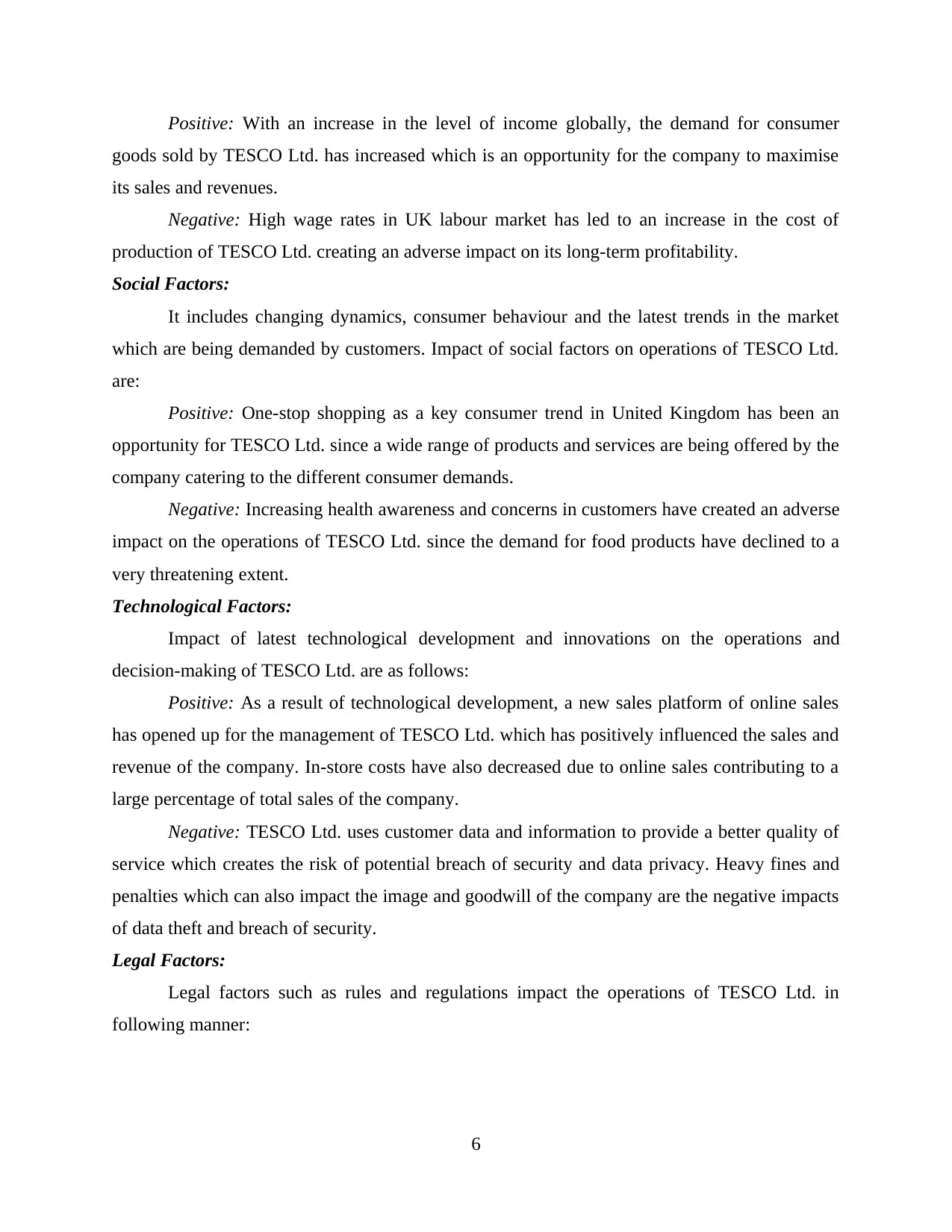
Positive: With an increase in the level of income globally, the demand for consumer
goods sold by TESCO Ltd. has increased which is an opportunity for the company to maximise
its sales and revenues.
Negative: High wage rates in UK labour market has led to an increase in the cost of
production of TESCO Ltd. creating an adverse impact on its long-term profitability.
Social Factors:
It includes changing dynamics, consumer behaviour and the latest trends in the market
which are being demanded by customers. Impact of social factors on operations of TESCO Ltd.
are:
Positive: One-stop shopping as a key consumer trend in United Kingdom has been an
opportunity for TESCO Ltd. since a wide range of products and services are being offered by the
company catering to the different consumer demands.
Negative: Increasing health awareness and concerns in customers have created an adverse
impact on the operations of TESCO Ltd. since the demand for food products have declined to a
very threatening extent.
Technological Factors:
Impact of latest technological development and innovations on the operations and
decision-making of TESCO Ltd. are as follows:
Positive: As a result of technological development, a new sales platform of online sales
has opened up for the management of TESCO Ltd. which has positively influenced the sales and
revenue of the company. In-store costs have also decreased due to online sales contributing to a
large percentage of total sales of the company.
Negative: TESCO Ltd. uses customer data and information to provide a better quality of
service which creates the risk of potential breach of security and data privacy. Heavy fines and
penalties which can also impact the image and goodwill of the company are the negative impacts
of data theft and breach of security.
Legal Factors:
Legal factors such as rules and regulations impact the operations of TESCO Ltd. in
following manner:
6
goods sold by TESCO Ltd. has increased which is an opportunity for the company to maximise
its sales and revenues.
Negative: High wage rates in UK labour market has led to an increase in the cost of
production of TESCO Ltd. creating an adverse impact on its long-term profitability.
Social Factors:
It includes changing dynamics, consumer behaviour and the latest trends in the market
which are being demanded by customers. Impact of social factors on operations of TESCO Ltd.
are:
Positive: One-stop shopping as a key consumer trend in United Kingdom has been an
opportunity for TESCO Ltd. since a wide range of products and services are being offered by the
company catering to the different consumer demands.
Negative: Increasing health awareness and concerns in customers have created an adverse
impact on the operations of TESCO Ltd. since the demand for food products have declined to a
very threatening extent.
Technological Factors:
Impact of latest technological development and innovations on the operations and
decision-making of TESCO Ltd. are as follows:
Positive: As a result of technological development, a new sales platform of online sales
has opened up for the management of TESCO Ltd. which has positively influenced the sales and
revenue of the company. In-store costs have also decreased due to online sales contributing to a
large percentage of total sales of the company.
Negative: TESCO Ltd. uses customer data and information to provide a better quality of
service which creates the risk of potential breach of security and data privacy. Heavy fines and
penalties which can also impact the image and goodwill of the company are the negative impacts
of data theft and breach of security.
Legal Factors:
Legal factors such as rules and regulations impact the operations of TESCO Ltd. in
following manner:
6
⊘ This is a preview!⊘
Do you want full access?
Subscribe today to unlock all pages.

Trusted by 1+ million students worldwide
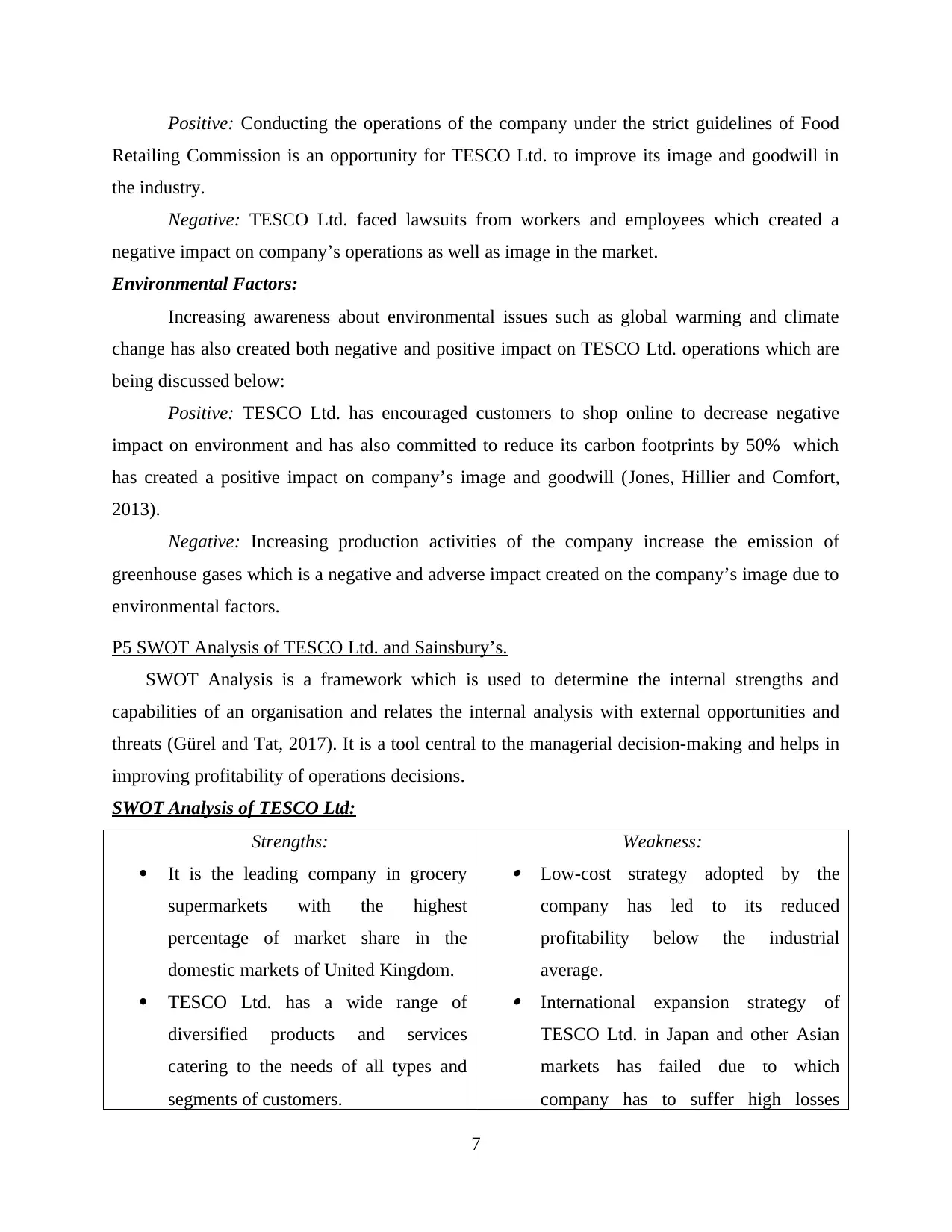
Positive: Conducting the operations of the company under the strict guidelines of Food
Retailing Commission is an opportunity for TESCO Ltd. to improve its image and goodwill in
the industry.
Negative: TESCO Ltd. faced lawsuits from workers and employees which created a
negative impact on company’s operations as well as image in the market.
Environmental Factors:
Increasing awareness about environmental issues such as global warming and climate
change has also created both negative and positive impact on TESCO Ltd. operations which are
being discussed below:
Positive: TESCO Ltd. has encouraged customers to shop online to decrease negative
impact on environment and has also committed to reduce its carbon footprints by 50% which
has created a positive impact on company’s image and goodwill (Jones, Hillier and Comfort,
2013).
Negative: Increasing production activities of the company increase the emission of
greenhouse gases which is a negative and adverse impact created on the company’s image due to
environmental factors.
P5 SWOT Analysis of TESCO Ltd. and Sainsbury’s.
SWOT Analysis is a framework which is used to determine the internal strengths and
capabilities of an organisation and relates the internal analysis with external opportunities and
threats (Gürel and Tat, 2017). It is a tool central to the managerial decision-making and helps in
improving profitability of operations decisions.
SWOT Analysis of TESCO Ltd:
Strengths:
It is the leading company in grocery
supermarkets with the highest
percentage of market share in the
domestic markets of United Kingdom.
TESCO Ltd. has a wide range of
diversified products and services
catering to the needs of all types and
segments of customers.
Weakness:
Low-cost strategy adopted by the
company has led to its reduced
profitability below the industrial
average.
International expansion strategy of
TESCO Ltd. in Japan and other Asian
markets has failed due to which
company has to suffer high losses
7
Retailing Commission is an opportunity for TESCO Ltd. to improve its image and goodwill in
the industry.
Negative: TESCO Ltd. faced lawsuits from workers and employees which created a
negative impact on company’s operations as well as image in the market.
Environmental Factors:
Increasing awareness about environmental issues such as global warming and climate
change has also created both negative and positive impact on TESCO Ltd. operations which are
being discussed below:
Positive: TESCO Ltd. has encouraged customers to shop online to decrease negative
impact on environment and has also committed to reduce its carbon footprints by 50% which
has created a positive impact on company’s image and goodwill (Jones, Hillier and Comfort,
2013).
Negative: Increasing production activities of the company increase the emission of
greenhouse gases which is a negative and adverse impact created on the company’s image due to
environmental factors.
P5 SWOT Analysis of TESCO Ltd. and Sainsbury’s.
SWOT Analysis is a framework which is used to determine the internal strengths and
capabilities of an organisation and relates the internal analysis with external opportunities and
threats (Gürel and Tat, 2017). It is a tool central to the managerial decision-making and helps in
improving profitability of operations decisions.
SWOT Analysis of TESCO Ltd:
Strengths:
It is the leading company in grocery
supermarkets with the highest
percentage of market share in the
domestic markets of United Kingdom.
TESCO Ltd. has a wide range of
diversified products and services
catering to the needs of all types and
segments of customers.
Weakness:
Low-cost strategy adopted by the
company has led to its reduced
profitability below the industrial
average.
International expansion strategy of
TESCO Ltd. in Japan and other Asian
markets has failed due to which
company has to suffer high losses
7
Paraphrase This Document
Need a fresh take? Get an instant paraphrase of this document with our AI Paraphraser
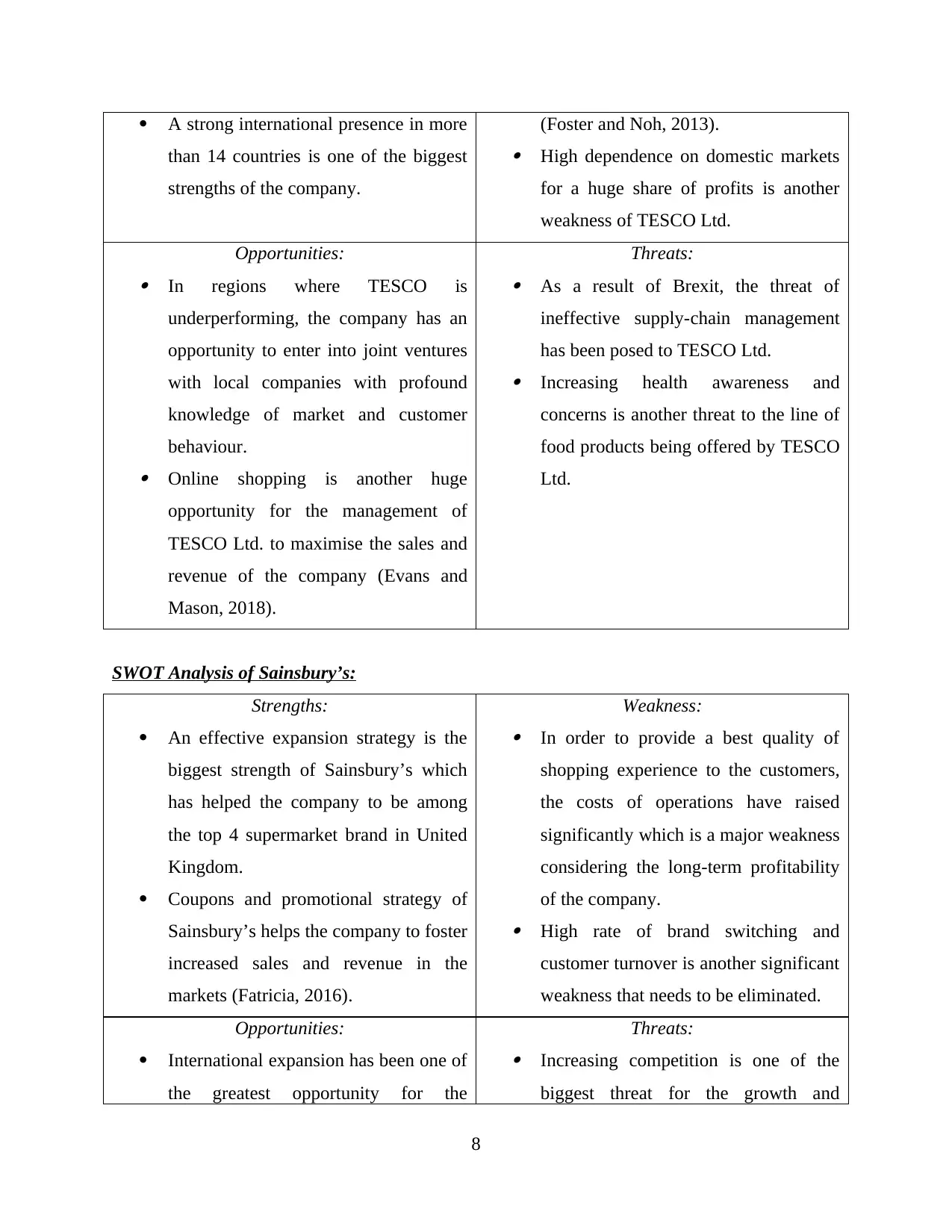
A strong international presence in more
than 14 countries is one of the biggest
strengths of the company.
(Foster and Noh, 2013).
High dependence on domestic markets
for a huge share of profits is another
weakness of TESCO Ltd.
Opportunities: In regions where TESCO is
underperforming, the company has an
opportunity to enter into joint ventures
with local companies with profound
knowledge of market and customer
behaviour. Online shopping is another huge
opportunity for the management of
TESCO Ltd. to maximise the sales and
revenue of the company (Evans and
Mason, 2018).
Threats:
As a result of Brexit, the threat of
ineffective supply-chain management
has been posed to TESCO Ltd.
Increasing health awareness and
concerns is another threat to the line of
food products being offered by TESCO
Ltd.
SWOT Analysis of Sainsbury’s:
Strengths:
An effective expansion strategy is the
biggest strength of Sainsbury’s which
has helped the company to be among
the top 4 supermarket brand in United
Kingdom.
Coupons and promotional strategy of
Sainsbury’s helps the company to foster
increased sales and revenue in the
markets (Fatricia, 2016).
Weakness:
In order to provide a best quality of
shopping experience to the customers,
the costs of operations have raised
significantly which is a major weakness
considering the long-term profitability
of the company.
High rate of brand switching and
customer turnover is another significant
weakness that needs to be eliminated.
Opportunities:
International expansion has been one of
the greatest opportunity for the
Threats:
Increasing competition is one of the
biggest threat for the growth and
8
than 14 countries is one of the biggest
strengths of the company.
(Foster and Noh, 2013).
High dependence on domestic markets
for a huge share of profits is another
weakness of TESCO Ltd.
Opportunities: In regions where TESCO is
underperforming, the company has an
opportunity to enter into joint ventures
with local companies with profound
knowledge of market and customer
behaviour. Online shopping is another huge
opportunity for the management of
TESCO Ltd. to maximise the sales and
revenue of the company (Evans and
Mason, 2018).
Threats:
As a result of Brexit, the threat of
ineffective supply-chain management
has been posed to TESCO Ltd.
Increasing health awareness and
concerns is another threat to the line of
food products being offered by TESCO
Ltd.
SWOT Analysis of Sainsbury’s:
Strengths:
An effective expansion strategy is the
biggest strength of Sainsbury’s which
has helped the company to be among
the top 4 supermarket brand in United
Kingdom.
Coupons and promotional strategy of
Sainsbury’s helps the company to foster
increased sales and revenue in the
markets (Fatricia, 2016).
Weakness:
In order to provide a best quality of
shopping experience to the customers,
the costs of operations have raised
significantly which is a major weakness
considering the long-term profitability
of the company.
High rate of brand switching and
customer turnover is another significant
weakness that needs to be eliminated.
Opportunities:
International expansion has been one of
the greatest opportunity for the
Threats:
Increasing competition is one of the
biggest threat for the growth and
8
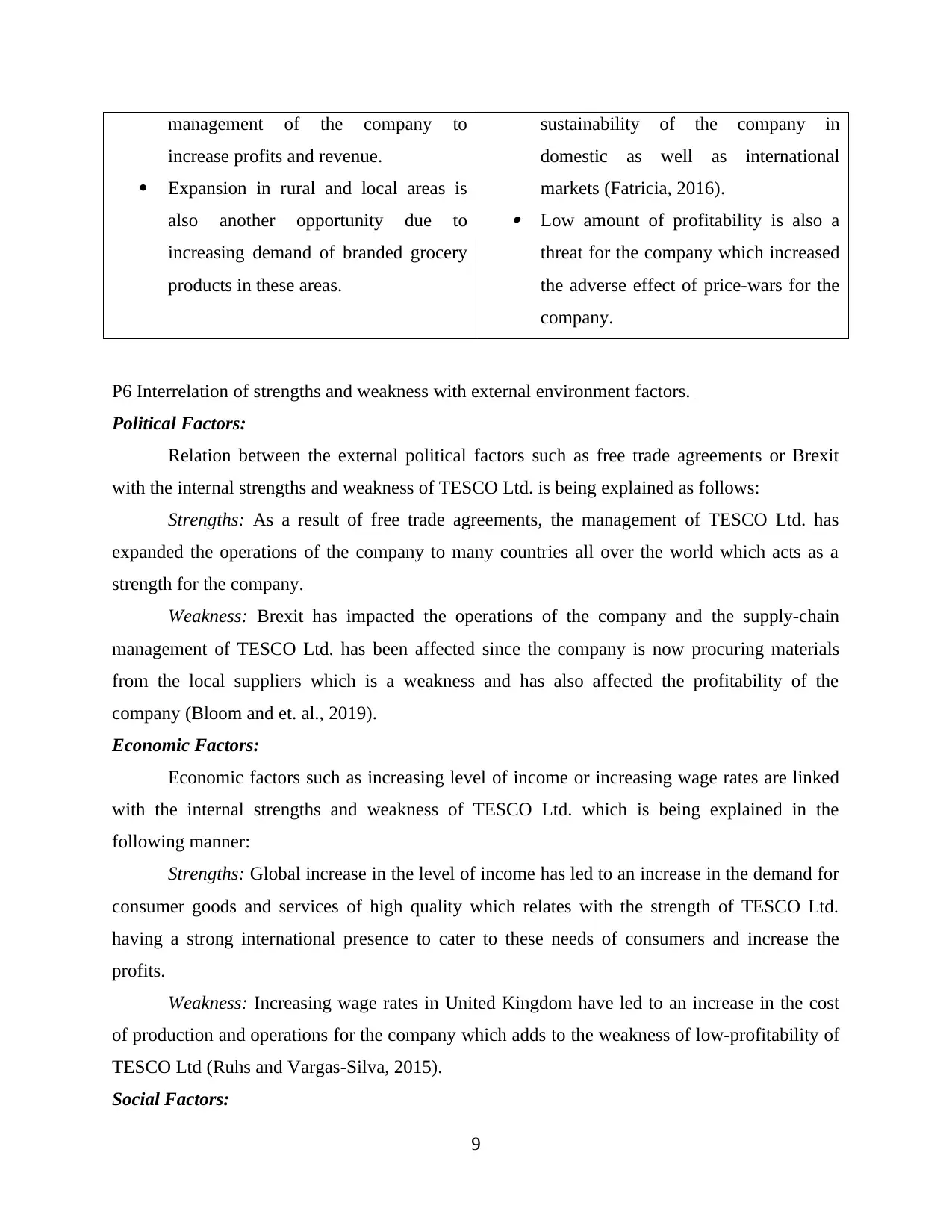
management of the company to
increase profits and revenue.
Expansion in rural and local areas is
also another opportunity due to
increasing demand of branded grocery
products in these areas.
sustainability of the company in
domestic as well as international
markets (Fatricia, 2016).
Low amount of profitability is also a
threat for the company which increased
the adverse effect of price-wars for the
company.
P6 Interrelation of strengths and weakness with external environment factors.
Political Factors:
Relation between the external political factors such as free trade agreements or Brexit
with the internal strengths and weakness of TESCO Ltd. is being explained as follows:
Strengths: As a result of free trade agreements, the management of TESCO Ltd. has
expanded the operations of the company to many countries all over the world which acts as a
strength for the company.
Weakness: Brexit has impacted the operations of the company and the supply-chain
management of TESCO Ltd. has been affected since the company is now procuring materials
from the local suppliers which is a weakness and has also affected the profitability of the
company (Bloom and et. al., 2019).
Economic Factors:
Economic factors such as increasing level of income or increasing wage rates are linked
with the internal strengths and weakness of TESCO Ltd. which is being explained in the
following manner:
Strengths: Global increase in the level of income has led to an increase in the demand for
consumer goods and services of high quality which relates with the strength of TESCO Ltd.
having a strong international presence to cater to these needs of consumers and increase the
profits.
Weakness: Increasing wage rates in United Kingdom have led to an increase in the cost
of production and operations for the company which adds to the weakness of low-profitability of
TESCO Ltd (Ruhs and Vargas-Silva, 2015).
Social Factors:
9
increase profits and revenue.
Expansion in rural and local areas is
also another opportunity due to
increasing demand of branded grocery
products in these areas.
sustainability of the company in
domestic as well as international
markets (Fatricia, 2016).
Low amount of profitability is also a
threat for the company which increased
the adverse effect of price-wars for the
company.
P6 Interrelation of strengths and weakness with external environment factors.
Political Factors:
Relation between the external political factors such as free trade agreements or Brexit
with the internal strengths and weakness of TESCO Ltd. is being explained as follows:
Strengths: As a result of free trade agreements, the management of TESCO Ltd. has
expanded the operations of the company to many countries all over the world which acts as a
strength for the company.
Weakness: Brexit has impacted the operations of the company and the supply-chain
management of TESCO Ltd. has been affected since the company is now procuring materials
from the local suppliers which is a weakness and has also affected the profitability of the
company (Bloom and et. al., 2019).
Economic Factors:
Economic factors such as increasing level of income or increasing wage rates are linked
with the internal strengths and weakness of TESCO Ltd. which is being explained in the
following manner:
Strengths: Global increase in the level of income has led to an increase in the demand for
consumer goods and services of high quality which relates with the strength of TESCO Ltd.
having a strong international presence to cater to these needs of consumers and increase the
profits.
Weakness: Increasing wage rates in United Kingdom have led to an increase in the cost
of production and operations for the company which adds to the weakness of low-profitability of
TESCO Ltd (Ruhs and Vargas-Silva, 2015).
Social Factors:
9
⊘ This is a preview!⊘
Do you want full access?
Subscribe today to unlock all pages.

Trusted by 1+ million students worldwide
1 out of 15
Related Documents
Your All-in-One AI-Powered Toolkit for Academic Success.
+13062052269
info@desklib.com
Available 24*7 on WhatsApp / Email
![[object Object]](/_next/static/media/star-bottom.7253800d.svg)
Unlock your academic potential
Copyright © 2020–2025 A2Z Services. All Rights Reserved. Developed and managed by ZUCOL.





